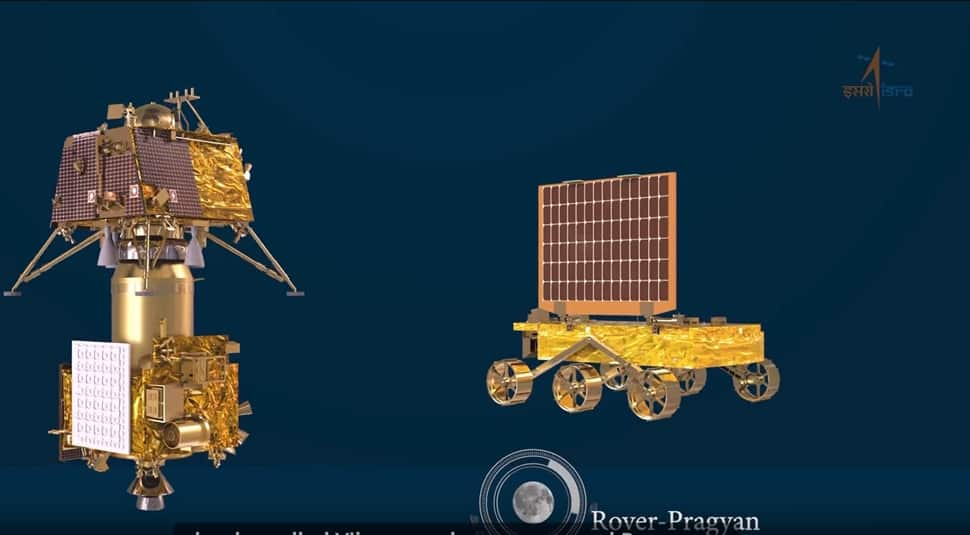Wow! Chandrayan-3 Rover 'Pragyan' To Leave Ashoka's Lion Emblem, ISRO Logo Imprints On Moon Surface
The Indian Space Research Organisation today launched its ambitious Chandrayaan-3 lunar mission from Satish Dhawan Space Centre in Andhra Pradesh. 'Fat boy' LVM3-M4 rocket took off with Chandrayaan-3 as part of the country's ambitious moon mission. The soft landing on the moon's surface is planned for late August. Scientists at the Satish Dhawan Space Centre are aiming at mastering the technology of soft-landing on the surface of the moon. Success would make India only the fourth country to achieve the feat after the United States, China and the former Soviet Union. Chandrayaan-3 is the third lunar exploration mission ready for takeoff in the fourth operational mission (M4) of the LVM3 launcher. While all these things will be on cards, do you know that the rover Pragyan will leave two imprints on the surface - one of Ashoka's Lion Emblem and the second of ISRO's logo?
LVM3 Rocket 'Fat Boy'
)
When the mission lands on the lunar surface, its rover will explore the secrets of the moon and send it back to Earth. Chandrayaan-3 mission consists of an indigenous propulsion module, a lander module and a rover with the objective of developing and demonstrating new technologies required for inter-planetary missions. The largest and heaviest LVM3 rocket (formerly GSLV MkIII), fondly called as 'fat boy' by ISRO scientists for its heavy-lift capability, has completed six consecutive successful missions.
Geo Transfer Orbit

Today's mission is the fourth operational flight of LVM3 which aims to launch the Chandrayaan-3 spacecraft into a Geo Transfer Orbit. According to scientists, around 16 minutes after lift-off, the propulsion module to get separated from the rocket and would orbit the earth for about 5-6 times in an elliptical cycle with 170 km closest and 36,500 km farthest from earth moving towards the lunar orbit.
Month-Long Journey

The propulsion module along with the lander, after gaining speed would proceed for an over a month-long journey towards reaching the orbit of the moon until it goes 100 km above the lunar surface. After reaching the desired position, the lander module would begin its descent for a soft landing on the south pole region of the moon and this action is expected to take place on August 23 or 24, scientists at ISRO said.
South Pole Landing

The moon's south pole region has been chosen because the Lunar South Pole remains much larger than that at the North pole. There could be a possibility of the presence of water in permanently shadowed areas around it. The significance of the Chandrayaan-3 mission, unlike its unsuccessful predecessor, is that the Propulsion Module has a payload -- SHAPE -- Spectro- polarimetry of HAbitable Planet Earth to study Earth from lunar orbit.
Exploring Moon's Surface

The lander module after landing on the surface of the moon has payloads including RAMBHA-LP which is to measure the near-surface plasma ions and electrons density and its changes, ChaSTE - Chandra's Surface Thermo Physical Experiment -- to carry out the measurements of thermal properties of lunar surface near-polar region and ILSA (Instrument for Lunar Seismic Activity) to measure seismicity around the landing site and delineating the structure of the lunar crust and mantle.
Rover Pragyan

The Rover Pragyan, after the soft-landing, would come out of the lander module and study the surface of the moon through its payloads APXS - Alpha Particle X-Ray Spectrometer - to derive the chemical composition and infer mineralogical composition to further enhance understanding of lunar surface. Rover, which has a mission life of 1 lunar day (14 Earth days) also has another payload Laser Induced Breakdown Spectroscope (LIBS) to determine the elemental composition of lunar soil and rocks around the lunar landing site, ISRO said.
Rover Pragyan Imprints

The back wheels of the rover have logos of ISRO and Ashoka's Lion Emblem. One wheel has the ISRO logo and the other has Ashoka's Lion Emblem. If the mission succeeds, the rover will leave these imprints on the moon's surface making India proud.
Trending Photos








